Assessment of Risk and Growth Pressures at Property Millionaires
VerifiedAdded on 2024/05/15
|12
|2941
|322
Report
AI Summary
This report examines the pressures faced by Property Millionaires due to rapid growth, focusing on performance expectations, expansion rate, and inexperienced employees. It also analyzes cultural pressures stemming from rewards for risk-taking, resistance to bad news, and internal competition. Furthermore, the report investigates information management issues, including transaction complexity, diagnostic performance gaps, and decentralized decision-making. A risk exposure calculator is included to quantify and assess the identified risks, providing insights into the challenges faced by the organization during its expansion phase. The report concludes by highlighting the critical areas that Property Millionaires need to address to mitigate risks and ensure sustainable growth.
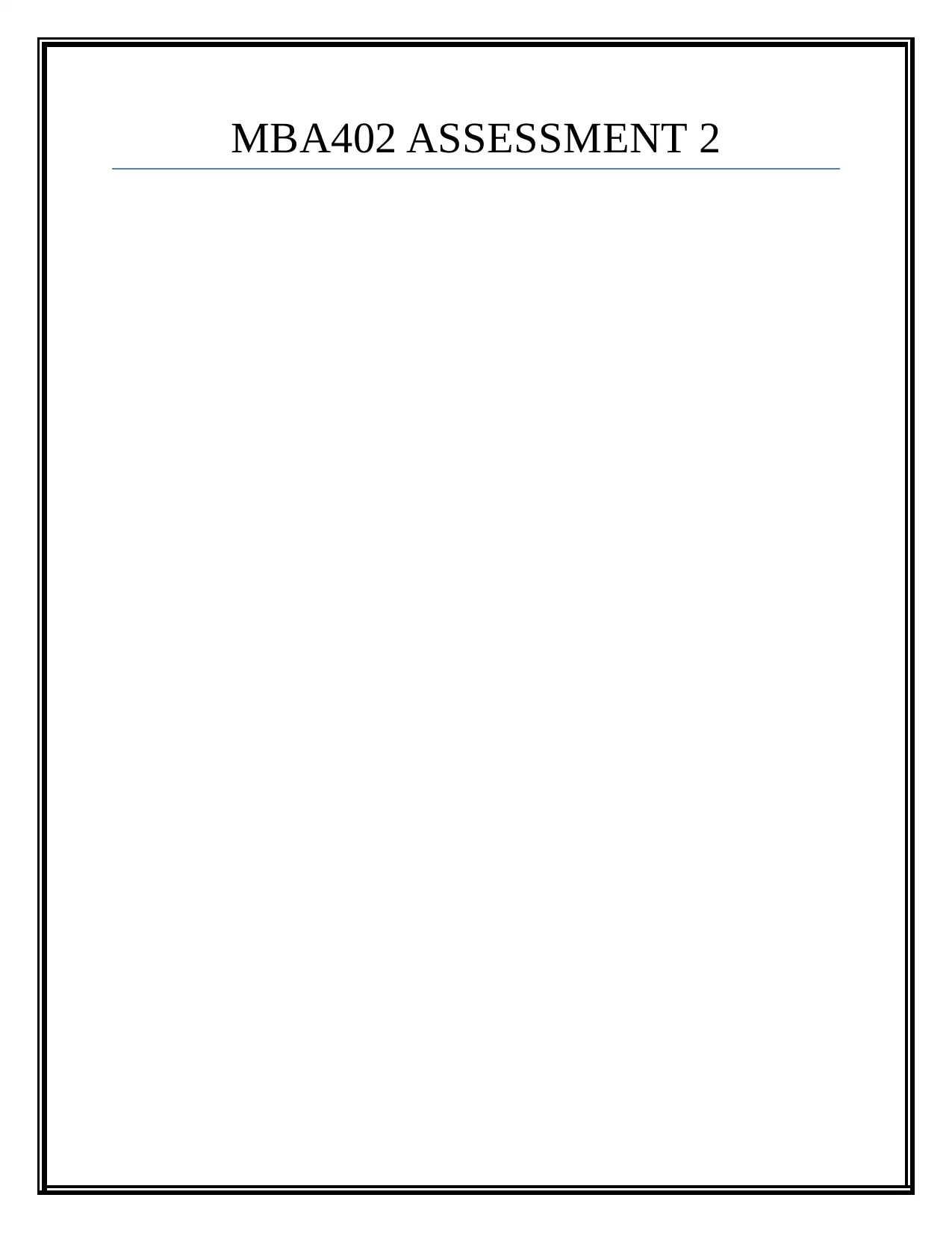
MBA402 ASSESSMENT 2
Paraphrase This Document
Need a fresh take? Get an instant paraphrase of this document with our AI Paraphraser
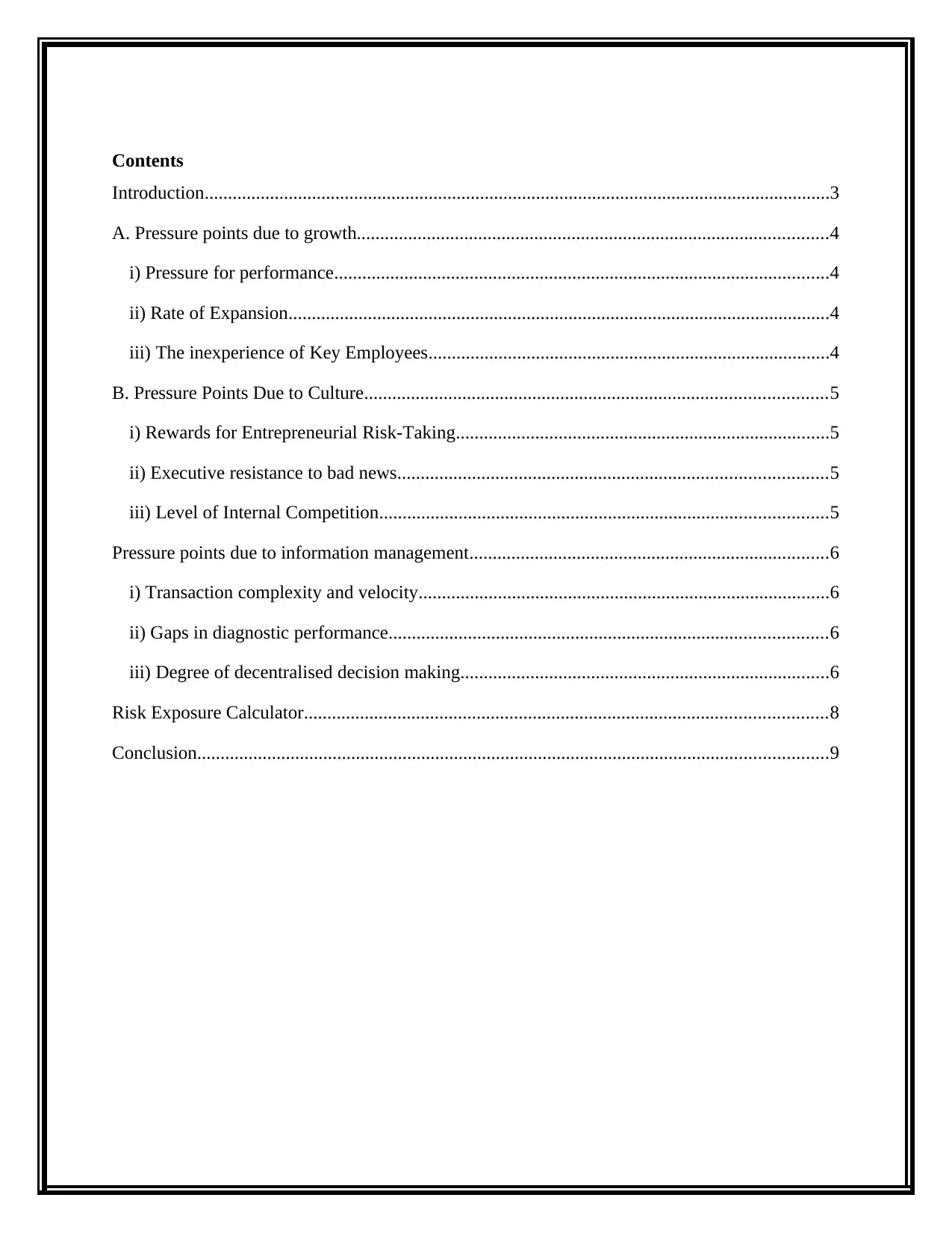
Contents
Introduction......................................................................................................................................3
A. Pressure points due to growth.....................................................................................................4
i) Pressure for performance..........................................................................................................4
ii) Rate of Expansion....................................................................................................................4
iii) The inexperience of Key Employees......................................................................................4
B. Pressure Points Due to Culture...................................................................................................5
i) Rewards for Entrepreneurial Risk-Taking................................................................................5
ii) Executive resistance to bad news............................................................................................5
iii) Level of Internal Competition................................................................................................5
Pressure points due to information management.............................................................................6
i) Transaction complexity and velocity........................................................................................6
ii) Gaps in diagnostic performance..............................................................................................6
iii) Degree of decentralised decision making...............................................................................6
Risk Exposure Calculator................................................................................................................8
Conclusion.......................................................................................................................................9
Introduction......................................................................................................................................3
A. Pressure points due to growth.....................................................................................................4
i) Pressure for performance..........................................................................................................4
ii) Rate of Expansion....................................................................................................................4
iii) The inexperience of Key Employees......................................................................................4
B. Pressure Points Due to Culture...................................................................................................5
i) Rewards for Entrepreneurial Risk-Taking................................................................................5
ii) Executive resistance to bad news............................................................................................5
iii) Level of Internal Competition................................................................................................5
Pressure points due to information management.............................................................................6
i) Transaction complexity and velocity........................................................................................6
ii) Gaps in diagnostic performance..............................................................................................6
iii) Degree of decentralised decision making...............................................................................6
Risk Exposure Calculator................................................................................................................8
Conclusion.......................................................................................................................................9
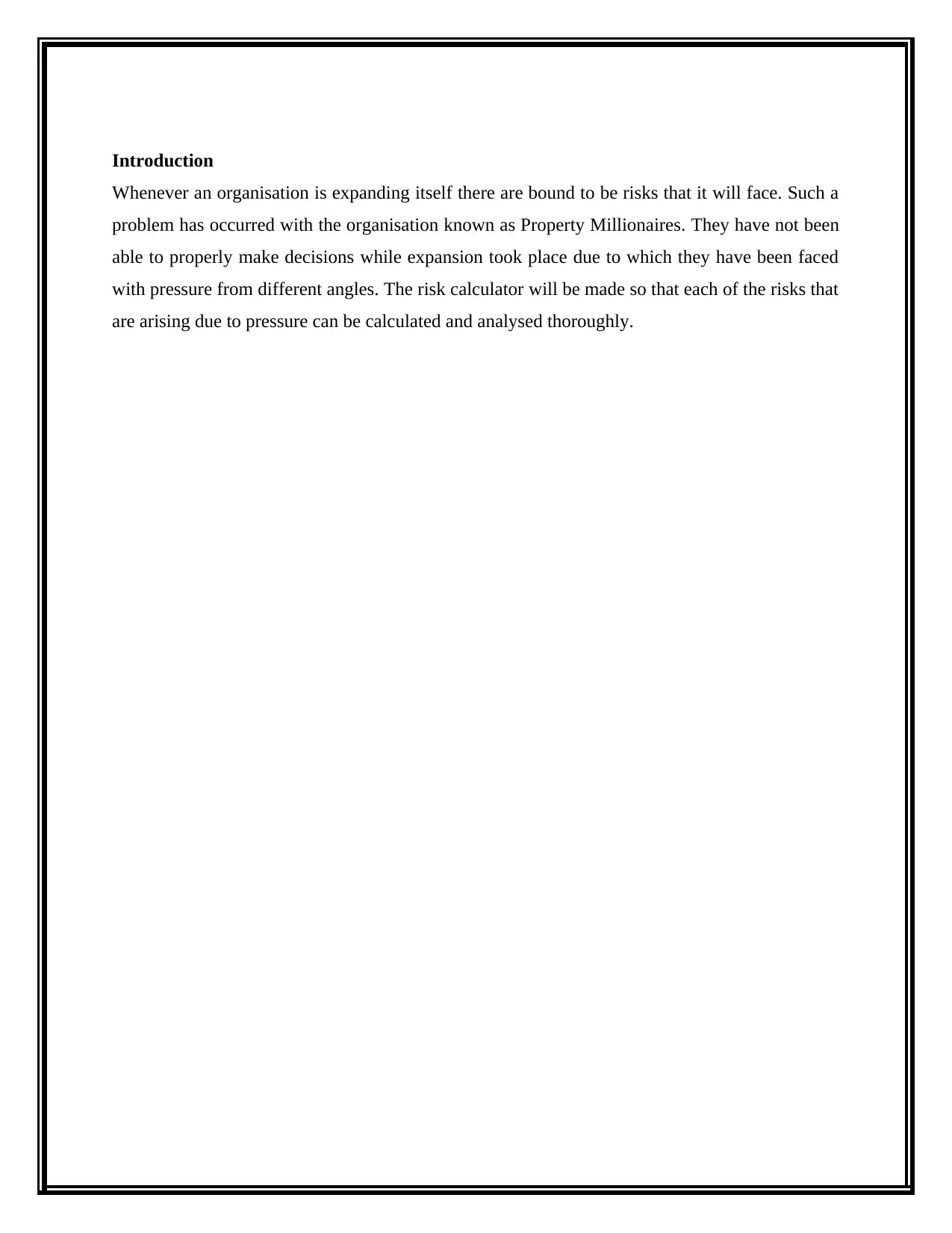
Introduction
Whenever an organisation is expanding itself there are bound to be risks that it will face. Such a
problem has occurred with the organisation known as Property Millionaires. They have not been
able to properly make decisions while expansion took place due to which they have been faced
with pressure from different angles. The risk calculator will be made so that each of the risks that
are arising due to pressure can be calculated and analysed thoroughly.
Whenever an organisation is expanding itself there are bound to be risks that it will face. Such a
problem has occurred with the organisation known as Property Millionaires. They have not been
able to properly make decisions while expansion took place due to which they have been faced
with pressure from different angles. The risk calculator will be made so that each of the risks that
are arising due to pressure can be calculated and analysed thoroughly.
⊘ This is a preview!⊘
Do you want full access?
Subscribe today to unlock all pages.

Trusted by 1+ million students worldwide
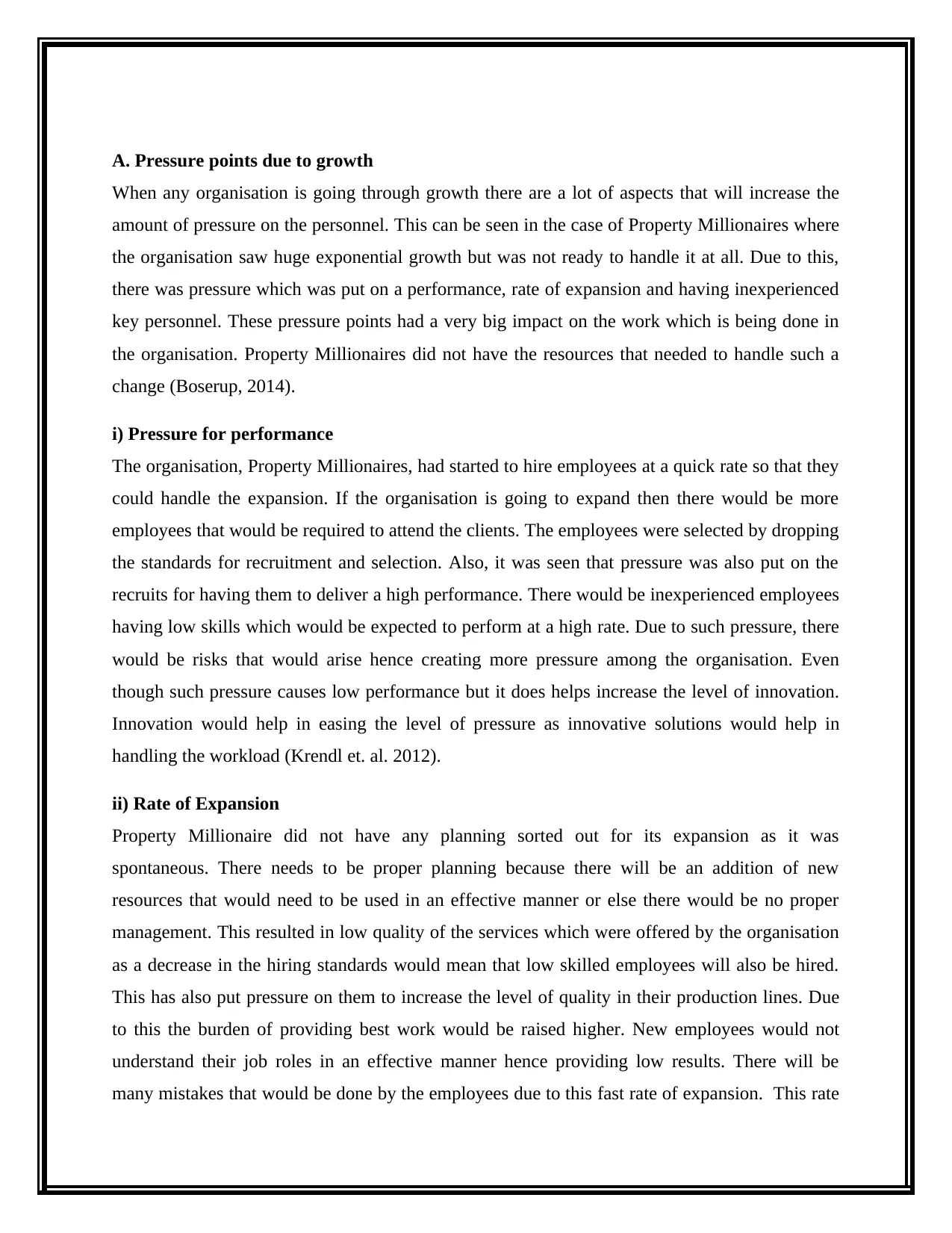
A. Pressure points due to growth
When any organisation is going through growth there are a lot of aspects that will increase the
amount of pressure on the personnel. This can be seen in the case of Property Millionaires where
the organisation saw huge exponential growth but was not ready to handle it at all. Due to this,
there was pressure which was put on a performance, rate of expansion and having inexperienced
key personnel. These pressure points had a very big impact on the work which is being done in
the organisation. Property Millionaires did not have the resources that needed to handle such a
change (Boserup, 2014).
i) Pressure for performance
The organisation, Property Millionaires, had started to hire employees at a quick rate so that they
could handle the expansion. If the organisation is going to expand then there would be more
employees that would be required to attend the clients. The employees were selected by dropping
the standards for recruitment and selection. Also, it was seen that pressure was also put on the
recruits for having them to deliver a high performance. There would be inexperienced employees
having low skills which would be expected to perform at a high rate. Due to such pressure, there
would be risks that would arise hence creating more pressure among the organisation. Even
though such pressure causes low performance but it does helps increase the level of innovation.
Innovation would help in easing the level of pressure as innovative solutions would help in
handling the workload (Krendl et. al. 2012).
ii) Rate of Expansion
Property Millionaire did not have any planning sorted out for its expansion as it was
spontaneous. There needs to be proper planning because there will be an addition of new
resources that would need to be used in an effective manner or else there would be no proper
management. This resulted in low quality of the services which were offered by the organisation
as a decrease in the hiring standards would mean that low skilled employees will also be hired.
This has also put pressure on them to increase the level of quality in their production lines. Due
to this the burden of providing best work would be raised higher. New employees would not
understand their job roles in an effective manner hence providing low results. There will be
many mistakes that would be done by the employees due to this fast rate of expansion. This rate
When any organisation is going through growth there are a lot of aspects that will increase the
amount of pressure on the personnel. This can be seen in the case of Property Millionaires where
the organisation saw huge exponential growth but was not ready to handle it at all. Due to this,
there was pressure which was put on a performance, rate of expansion and having inexperienced
key personnel. These pressure points had a very big impact on the work which is being done in
the organisation. Property Millionaires did not have the resources that needed to handle such a
change (Boserup, 2014).
i) Pressure for performance
The organisation, Property Millionaires, had started to hire employees at a quick rate so that they
could handle the expansion. If the organisation is going to expand then there would be more
employees that would be required to attend the clients. The employees were selected by dropping
the standards for recruitment and selection. Also, it was seen that pressure was also put on the
recruits for having them to deliver a high performance. There would be inexperienced employees
having low skills which would be expected to perform at a high rate. Due to such pressure, there
would be risks that would arise hence creating more pressure among the organisation. Even
though such pressure causes low performance but it does helps increase the level of innovation.
Innovation would help in easing the level of pressure as innovative solutions would help in
handling the workload (Krendl et. al. 2012).
ii) Rate of Expansion
Property Millionaire did not have any planning sorted out for its expansion as it was
spontaneous. There needs to be proper planning because there will be an addition of new
resources that would need to be used in an effective manner or else there would be no proper
management. This resulted in low quality of the services which were offered by the organisation
as a decrease in the hiring standards would mean that low skilled employees will also be hired.
This has also put pressure on them to increase the level of quality in their production lines. Due
to this the burden of providing best work would be raised higher. New employees would not
understand their job roles in an effective manner hence providing low results. There will be
many mistakes that would be done by the employees due to this fast rate of expansion. This rate
Paraphrase This Document
Need a fresh take? Get an instant paraphrase of this document with our AI Paraphraser
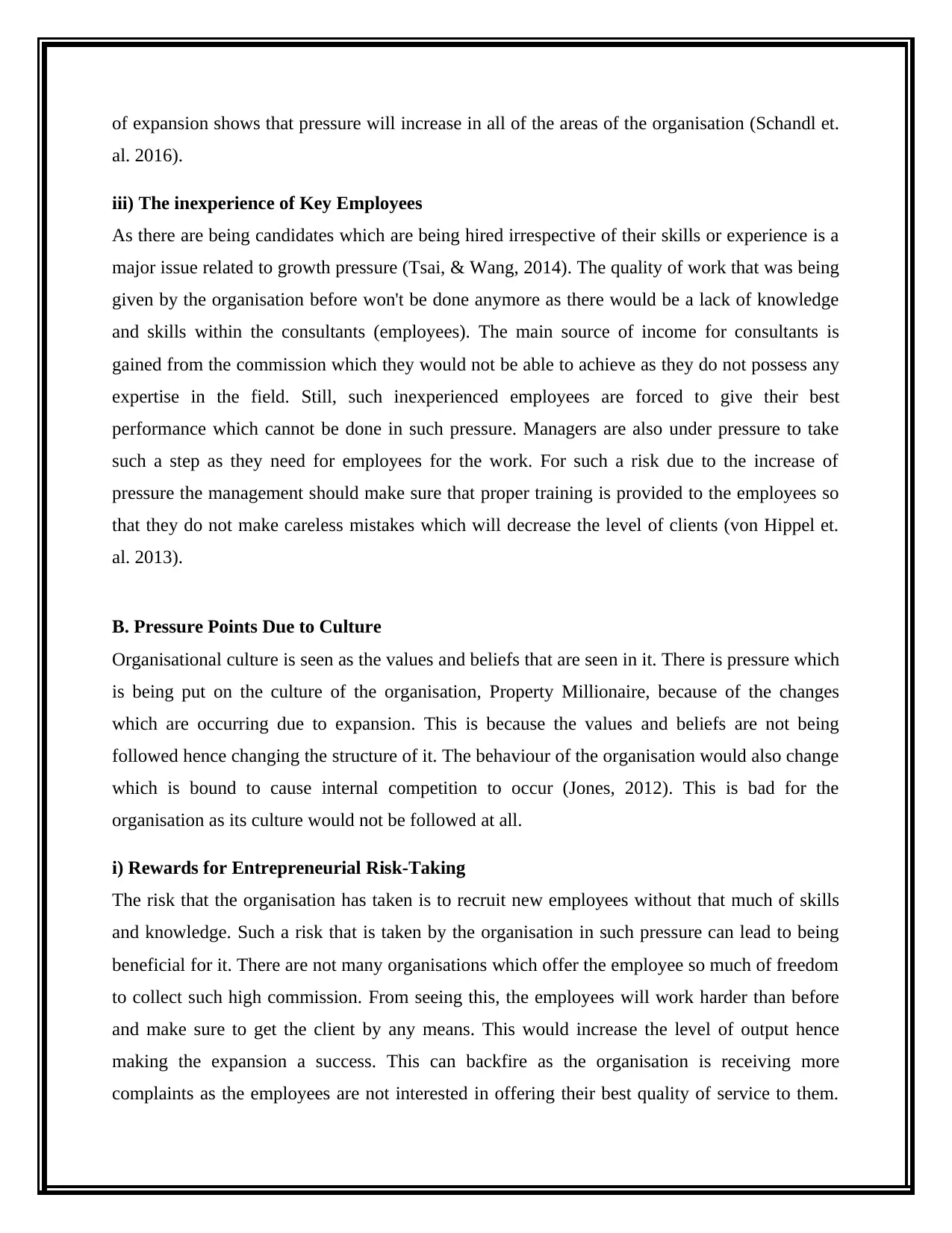
of expansion shows that pressure will increase in all of the areas of the organisation (Schandl et.
al. 2016).
iii) The inexperience of Key Employees
As there are being candidates which are being hired irrespective of their skills or experience is a
major issue related to growth pressure (Tsai, & Wang, 2014). The quality of work that was being
given by the organisation before won't be done anymore as there would be a lack of knowledge
and skills within the consultants (employees). The main source of income for consultants is
gained from the commission which they would not be able to achieve as they do not possess any
expertise in the field. Still, such inexperienced employees are forced to give their best
performance which cannot be done in such pressure. Managers are also under pressure to take
such a step as they need for employees for the work. For such a risk due to the increase of
pressure the management should make sure that proper training is provided to the employees so
that they do not make careless mistakes which will decrease the level of clients (von Hippel et.
al. 2013).
B. Pressure Points Due to Culture
Organisational culture is seen as the values and beliefs that are seen in it. There is pressure which
is being put on the culture of the organisation, Property Millionaire, because of the changes
which are occurring due to expansion. This is because the values and beliefs are not being
followed hence changing the structure of it. The behaviour of the organisation would also change
which is bound to cause internal competition to occur (Jones, 2012). This is bad for the
organisation as its culture would not be followed at all.
i) Rewards for Entrepreneurial Risk-Taking
The risk that the organisation has taken is to recruit new employees without that much of skills
and knowledge. Such a risk that is taken by the organisation in such pressure can lead to being
beneficial for it. There are not many organisations which offer the employee so much of freedom
to collect such high commission. From seeing this, the employees will work harder than before
and make sure to get the client by any means. This would increase the level of output hence
making the expansion a success. This can backfire as the organisation is receiving more
complaints as the employees are not interested in offering their best quality of service to them.
al. 2016).
iii) The inexperience of Key Employees
As there are being candidates which are being hired irrespective of their skills or experience is a
major issue related to growth pressure (Tsai, & Wang, 2014). The quality of work that was being
given by the organisation before won't be done anymore as there would be a lack of knowledge
and skills within the consultants (employees). The main source of income for consultants is
gained from the commission which they would not be able to achieve as they do not possess any
expertise in the field. Still, such inexperienced employees are forced to give their best
performance which cannot be done in such pressure. Managers are also under pressure to take
such a step as they need for employees for the work. For such a risk due to the increase of
pressure the management should make sure that proper training is provided to the employees so
that they do not make careless mistakes which will decrease the level of clients (von Hippel et.
al. 2013).
B. Pressure Points Due to Culture
Organisational culture is seen as the values and beliefs that are seen in it. There is pressure which
is being put on the culture of the organisation, Property Millionaire, because of the changes
which are occurring due to expansion. This is because the values and beliefs are not being
followed hence changing the structure of it. The behaviour of the organisation would also change
which is bound to cause internal competition to occur (Jones, 2012). This is bad for the
organisation as its culture would not be followed at all.
i) Rewards for Entrepreneurial Risk-Taking
The risk that the organisation has taken is to recruit new employees without that much of skills
and knowledge. Such a risk that is taken by the organisation in such pressure can lead to being
beneficial for it. There are not many organisations which offer the employee so much of freedom
to collect such high commission. From seeing this, the employees will work harder than before
and make sure to get the client by any means. This would increase the level of output hence
making the expansion a success. This can backfire as the organisation is receiving more
complaints as the employees are not interested in offering their best quality of service to them.

Also, even though solving risks is reward there is still the problem of no information that is being
shared. This leads to less creativity being done in the organisation. There should be rewards to
employees that provide solutions that are innovative so that problems can be solved in a quick
and effective manner (Goetz et. al. 2016).
ii) Executive resistance to bad news
It is seen most of the times that when an organisation grows or expands then the executives
becoming accustomed not here any bad news. This is a bad aspect as they would be ignoring
some risks that would, later on, become crucial to solving or a major problem for the
organisation. Instead, such executives would want to be surrounded by people who would give
out positive vibes hence increasing their confidence levels. The regional managers at Property
Millionaires do not have too much time to listen to the problems expressed by the consultants as
they do not possess that much of knowledge about the seminars. They even lack of in sending
performance reports because they know that the reports would not be good at all. The only focus
is on the sales which are generated by the seminars. Also, the problems which are solved are not
even that much of need to be solved (Franks et. al. 2014).
iii) Level of Internal Competition
The level of internal competition has also increased in the organisation due to the increase in
pressure, especially at the top level of management. This is considered to be bad as only
importance would be given to self and there would be no motivation to the employees. There
would be no information shared hence creating a lack of communication and degrading the
culture of the organisation. It is seen that the senior level of management does not work as a
team but rather independently. The content that is used for the seminar is developed individually
and is only given to the team when there is some sort of value which is created. Teamwork
would lead to better results and this is not being done which is leading to a higher rate of failure
frequency of the new seminars. Thinking about oneself is such pressure would only lead to loss
as the level of work and its quality would have increased by a lot.
Pressure points due to information management
The result of expansion at such a fast rate often leads to mismanagement of information (Alon et.
al. 2012). This is not a good sign as information needs to be passed in Property Millionaires at a
shared. This leads to less creativity being done in the organisation. There should be rewards to
employees that provide solutions that are innovative so that problems can be solved in a quick
and effective manner (Goetz et. al. 2016).
ii) Executive resistance to bad news
It is seen most of the times that when an organisation grows or expands then the executives
becoming accustomed not here any bad news. This is a bad aspect as they would be ignoring
some risks that would, later on, become crucial to solving or a major problem for the
organisation. Instead, such executives would want to be surrounded by people who would give
out positive vibes hence increasing their confidence levels. The regional managers at Property
Millionaires do not have too much time to listen to the problems expressed by the consultants as
they do not possess that much of knowledge about the seminars. They even lack of in sending
performance reports because they know that the reports would not be good at all. The only focus
is on the sales which are generated by the seminars. Also, the problems which are solved are not
even that much of need to be solved (Franks et. al. 2014).
iii) Level of Internal Competition
The level of internal competition has also increased in the organisation due to the increase in
pressure, especially at the top level of management. This is considered to be bad as only
importance would be given to self and there would be no motivation to the employees. There
would be no information shared hence creating a lack of communication and degrading the
culture of the organisation. It is seen that the senior level of management does not work as a
team but rather independently. The content that is used for the seminar is developed individually
and is only given to the team when there is some sort of value which is created. Teamwork
would lead to better results and this is not being done which is leading to a higher rate of failure
frequency of the new seminars. Thinking about oneself is such pressure would only lead to loss
as the level of work and its quality would have increased by a lot.
Pressure points due to information management
The result of expansion at such a fast rate often leads to mismanagement of information (Alon et.
al. 2012). This is not a good sign as information needs to be passed in Property Millionaires at a
⊘ This is a preview!⊘
Do you want full access?
Subscribe today to unlock all pages.

Trusted by 1+ million students worldwide
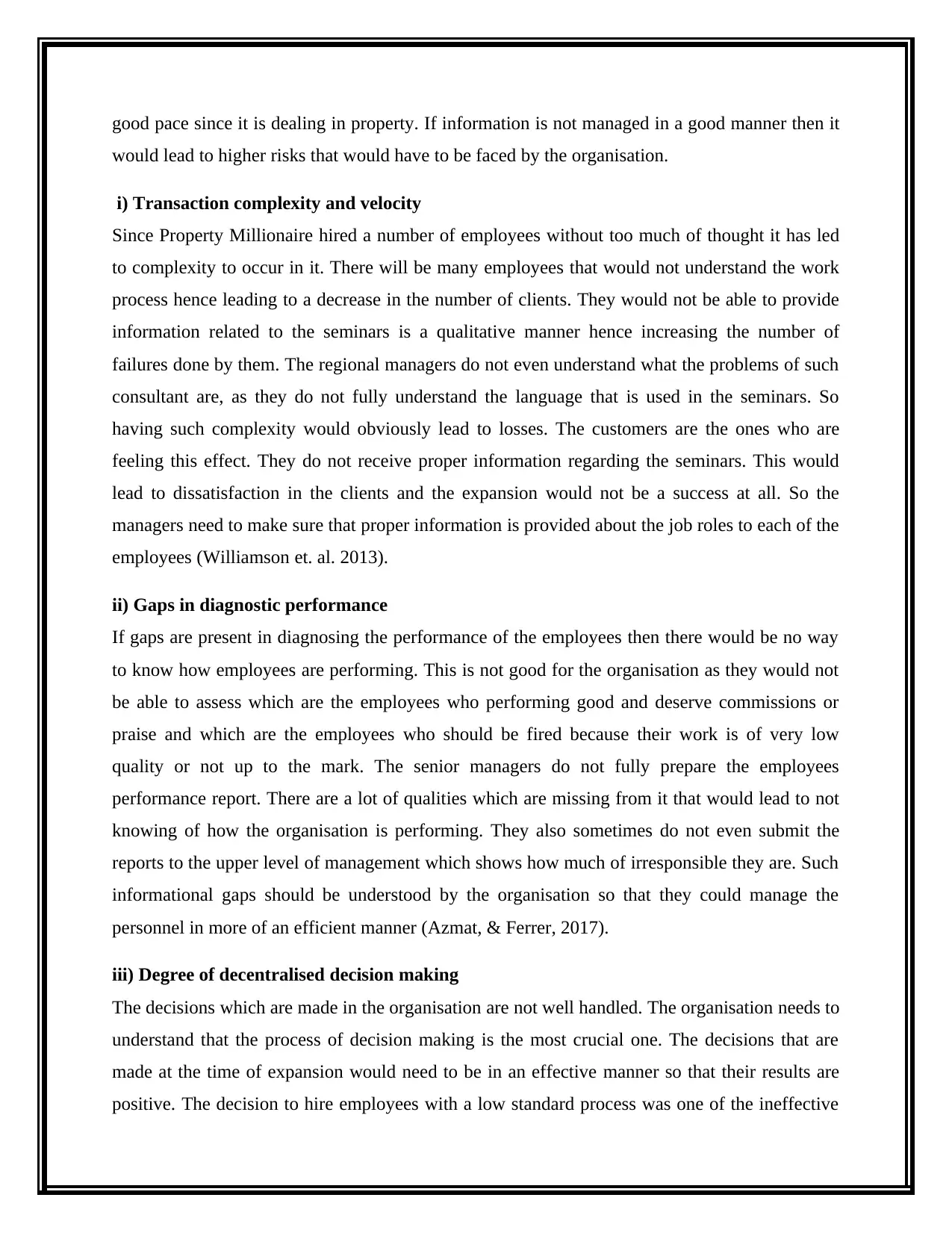
good pace since it is dealing in property. If information is not managed in a good manner then it
would lead to higher risks that would have to be faced by the organisation.
i) Transaction complexity and velocity
Since Property Millionaire hired a number of employees without too much of thought it has led
to complexity to occur in it. There will be many employees that would not understand the work
process hence leading to a decrease in the number of clients. They would not be able to provide
information related to the seminars is a qualitative manner hence increasing the number of
failures done by them. The regional managers do not even understand what the problems of such
consultant are, as they do not fully understand the language that is used in the seminars. So
having such complexity would obviously lead to losses. The customers are the ones who are
feeling this effect. They do not receive proper information regarding the seminars. This would
lead to dissatisfaction in the clients and the expansion would not be a success at all. So the
managers need to make sure that proper information is provided about the job roles to each of the
employees (Williamson et. al. 2013).
ii) Gaps in diagnostic performance
If gaps are present in diagnosing the performance of the employees then there would be no way
to know how employees are performing. This is not good for the organisation as they would not
be able to assess which are the employees who performing good and deserve commissions or
praise and which are the employees who should be fired because their work is of very low
quality or not up to the mark. The senior managers do not fully prepare the employees
performance report. There are a lot of qualities which are missing from it that would lead to not
knowing of how the organisation is performing. They also sometimes do not even submit the
reports to the upper level of management which shows how much of irresponsible they are. Such
informational gaps should be understood by the organisation so that they could manage the
personnel in more of an efficient manner (Azmat, & Ferrer, 2017).
iii) Degree of decentralised decision making
The decisions which are made in the organisation are not well handled. The organisation needs to
understand that the process of decision making is the most crucial one. The decisions that are
made at the time of expansion would need to be in an effective manner so that their results are
positive. The decision to hire employees with a low standard process was one of the ineffective
would lead to higher risks that would have to be faced by the organisation.
i) Transaction complexity and velocity
Since Property Millionaire hired a number of employees without too much of thought it has led
to complexity to occur in it. There will be many employees that would not understand the work
process hence leading to a decrease in the number of clients. They would not be able to provide
information related to the seminars is a qualitative manner hence increasing the number of
failures done by them. The regional managers do not even understand what the problems of such
consultant are, as they do not fully understand the language that is used in the seminars. So
having such complexity would obviously lead to losses. The customers are the ones who are
feeling this effect. They do not receive proper information regarding the seminars. This would
lead to dissatisfaction in the clients and the expansion would not be a success at all. So the
managers need to make sure that proper information is provided about the job roles to each of the
employees (Williamson et. al. 2013).
ii) Gaps in diagnostic performance
If gaps are present in diagnosing the performance of the employees then there would be no way
to know how employees are performing. This is not good for the organisation as they would not
be able to assess which are the employees who performing good and deserve commissions or
praise and which are the employees who should be fired because their work is of very low
quality or not up to the mark. The senior managers do not fully prepare the employees
performance report. There are a lot of qualities which are missing from it that would lead to not
knowing of how the organisation is performing. They also sometimes do not even submit the
reports to the upper level of management which shows how much of irresponsible they are. Such
informational gaps should be understood by the organisation so that they could manage the
personnel in more of an efficient manner (Azmat, & Ferrer, 2017).
iii) Degree of decentralised decision making
The decisions which are made in the organisation are not well handled. The organisation needs to
understand that the process of decision making is the most crucial one. The decisions that are
made at the time of expansion would need to be in an effective manner so that their results are
positive. The decision to hire employees with a low standard process was one of the ineffective
Paraphrase This Document
Need a fresh take? Get an instant paraphrase of this document with our AI Paraphraser
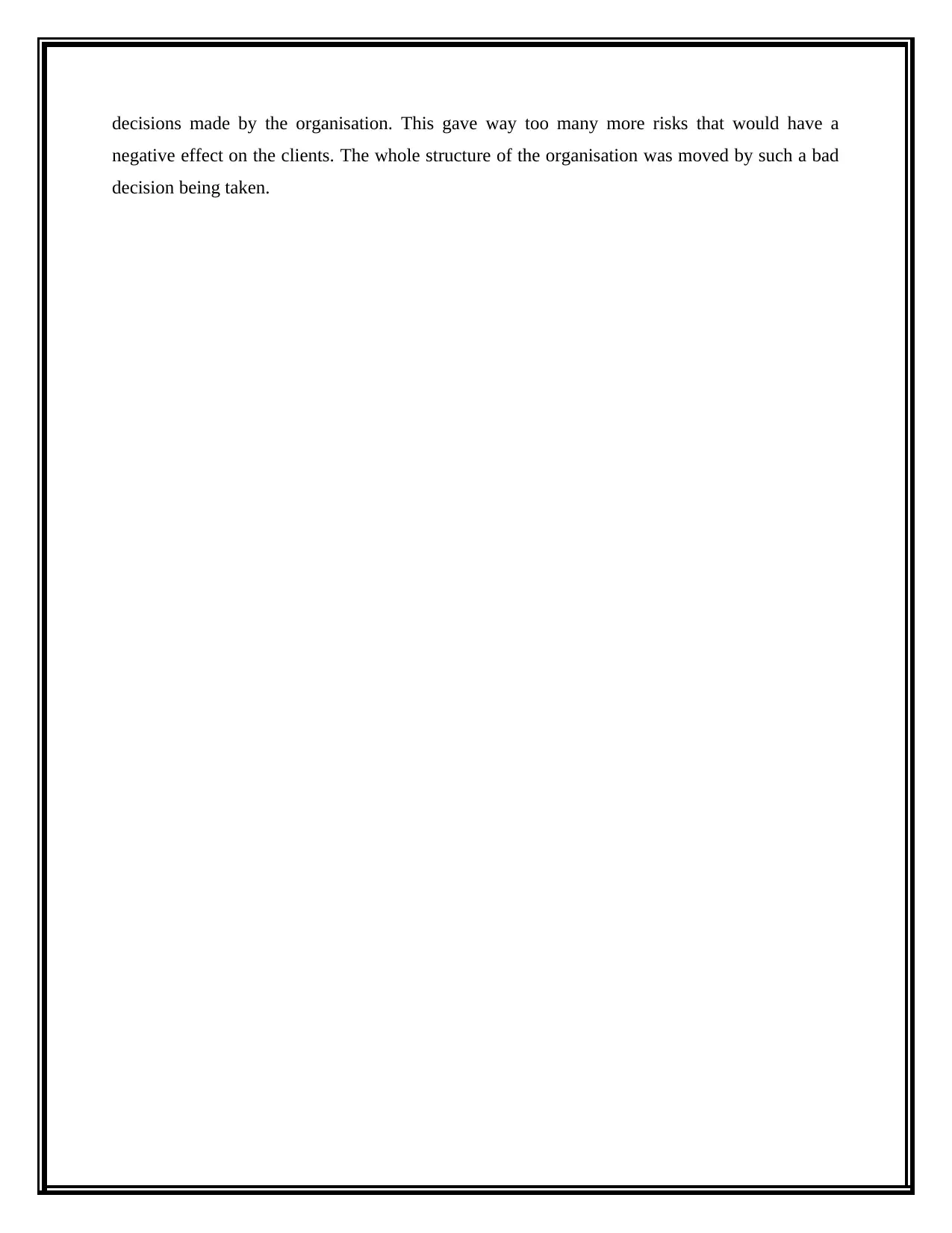
decisions made by the organisation. This gave way too many more risks that would have a
negative effect on the clients. The whole structure of the organisation was moved by such a bad
decision being taken.
negative effect on the clients. The whole structure of the organisation was moved by such a bad
decision being taken.
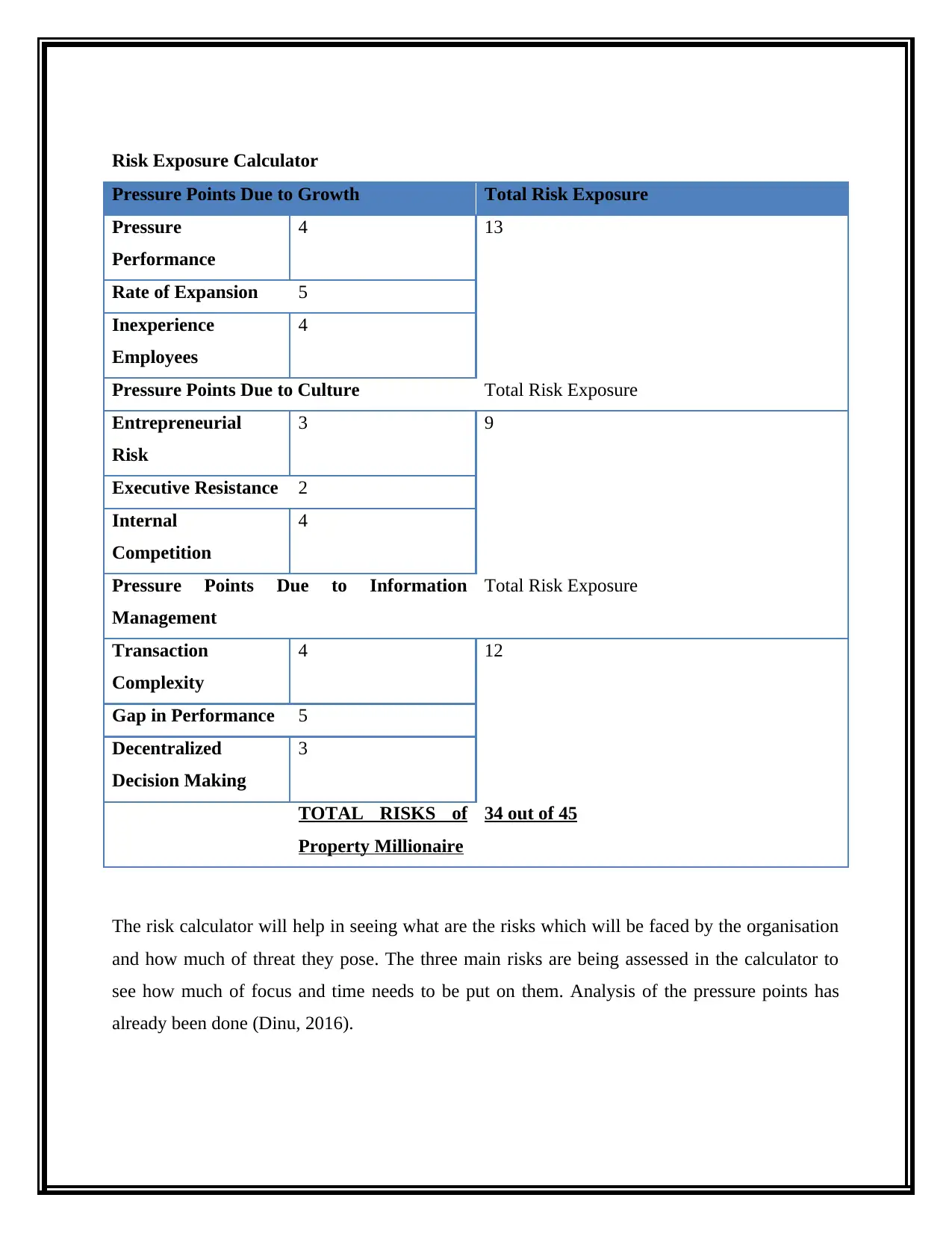
Risk Exposure Calculator
Pressure Points Due to Growth Total Risk Exposure
Pressure
Performance
4 13
Rate of Expansion 5
Inexperience
Employees
4
Pressure Points Due to Culture Total Risk Exposure
Entrepreneurial
Risk
3 9
Executive Resistance 2
Internal
Competition
4
Pressure Points Due to Information
Management
Total Risk Exposure
Transaction
Complexity
4 12
Gap in Performance 5
Decentralized
Decision Making
3
TOTAL RISKS of
Property Millionaire
34 out of 45
The risk calculator will help in seeing what are the risks which will be faced by the organisation
and how much of threat they pose. The three main risks are being assessed in the calculator to
see how much of focus and time needs to be put on them. Analysis of the pressure points has
already been done (Dinu, 2016).
Pressure Points Due to Growth Total Risk Exposure
Pressure
Performance
4 13
Rate of Expansion 5
Inexperience
Employees
4
Pressure Points Due to Culture Total Risk Exposure
Entrepreneurial
Risk
3 9
Executive Resistance 2
Internal
Competition
4
Pressure Points Due to Information
Management
Total Risk Exposure
Transaction
Complexity
4 12
Gap in Performance 5
Decentralized
Decision Making
3
TOTAL RISKS of
Property Millionaire
34 out of 45
The risk calculator will help in seeing what are the risks which will be faced by the organisation
and how much of threat they pose. The three main risks are being assessed in the calculator to
see how much of focus and time needs to be put on them. Analysis of the pressure points has
already been done (Dinu, 2016).
⊘ This is a preview!⊘
Do you want full access?
Subscribe today to unlock all pages.

Trusted by 1+ million students worldwide
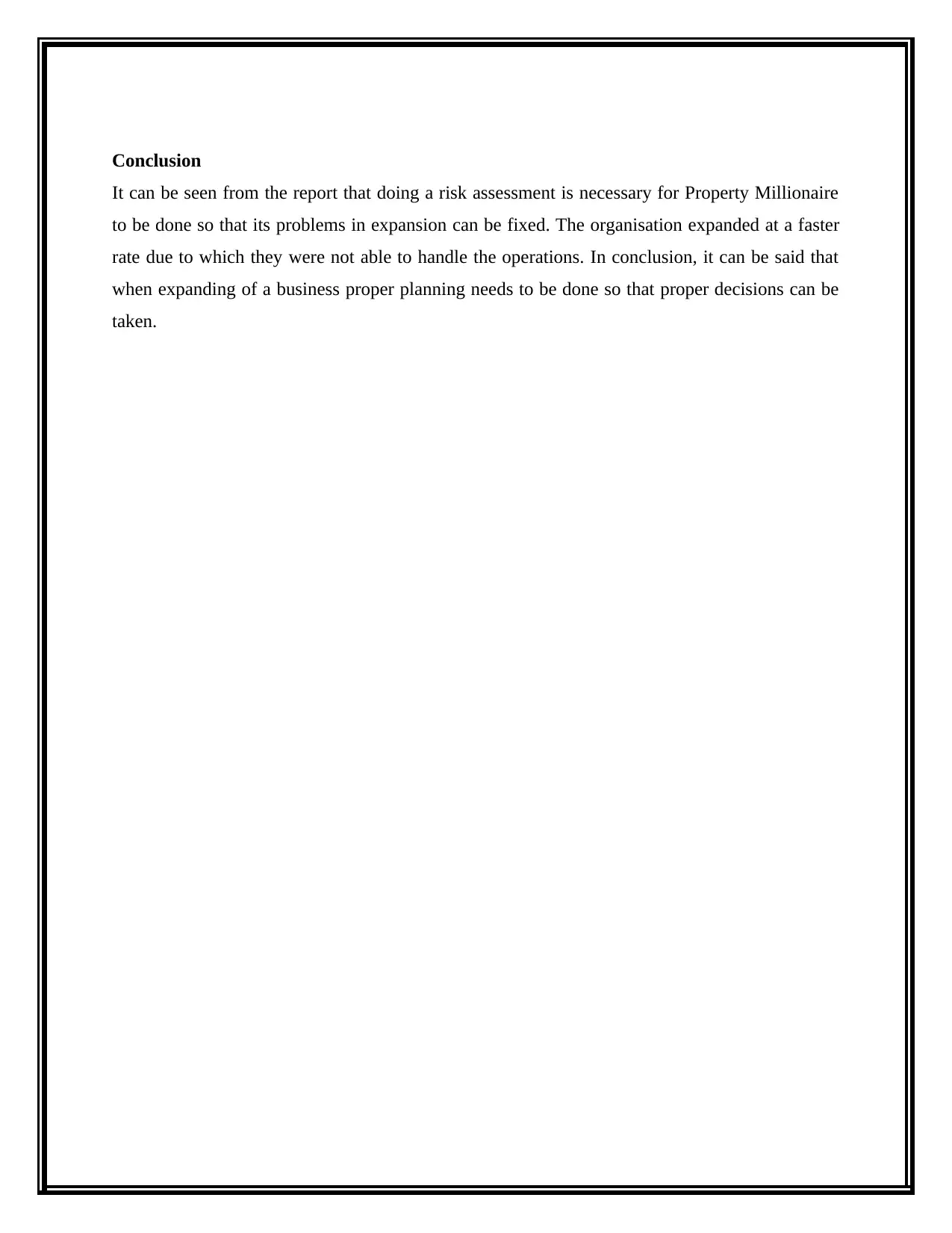
Conclusion
It can be seen from the report that doing a risk assessment is necessary for Property Millionaire
to be done so that its problems in expansion can be fixed. The organisation expanded at a faster
rate due to which they were not able to handle the operations. In conclusion, it can be said that
when expanding of a business proper planning needs to be done so that proper decisions can be
taken.
It can be seen from the report that doing a risk assessment is necessary for Property Millionaire
to be done so that its problems in expansion can be fixed. The organisation expanded at a faster
rate due to which they were not able to handle the operations. In conclusion, it can be said that
when expanding of a business proper planning needs to be done so that proper decisions can be
taken.
Paraphrase This Document
Need a fresh take? Get an instant paraphrase of this document with our AI Paraphraser
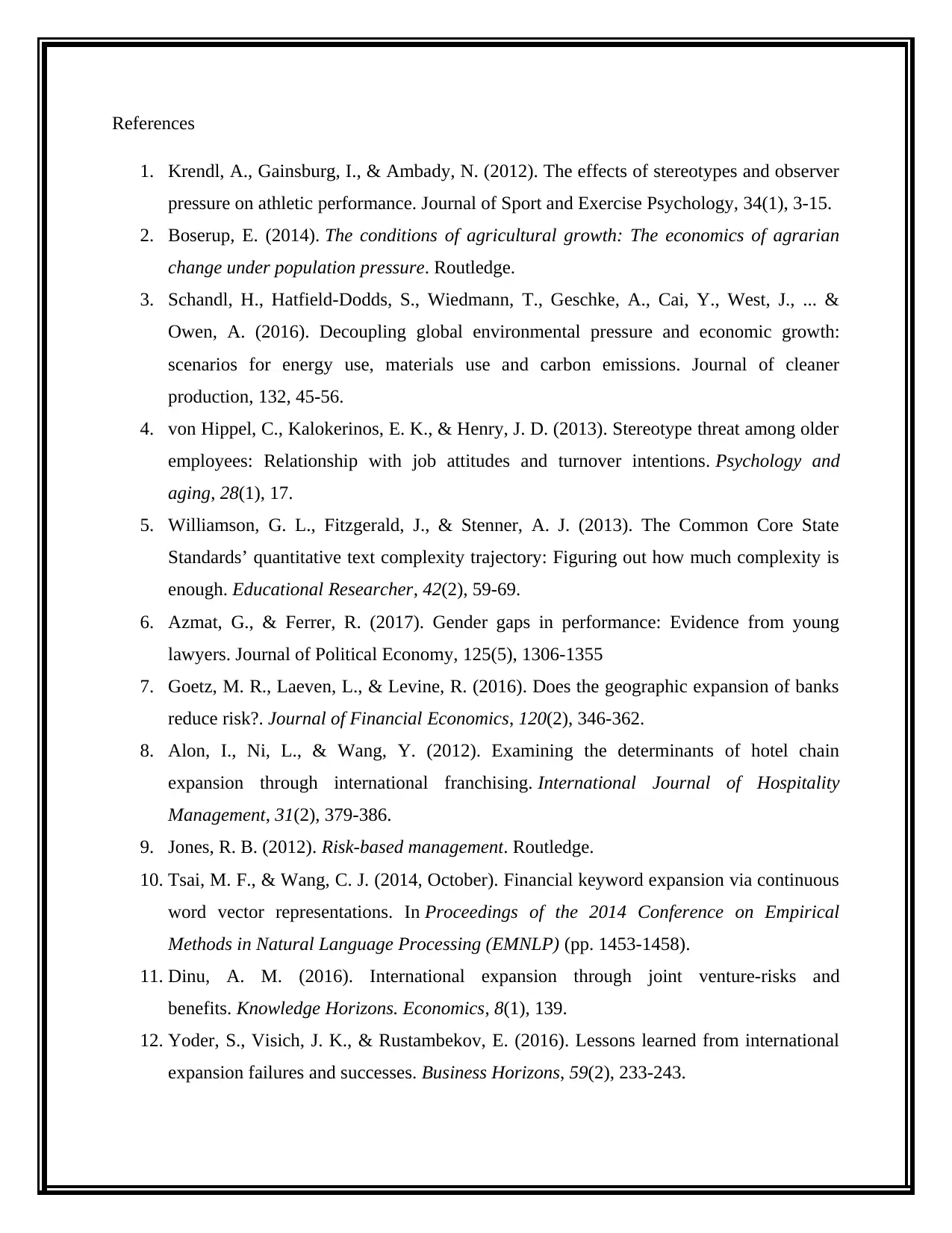
References
1. Krendl, A., Gainsburg, I., & Ambady, N. (2012). The effects of stereotypes and observer
pressure on athletic performance. Journal of Sport and Exercise Psychology, 34(1), 3-15.
2. Boserup, E. (2014). The conditions of agricultural growth: The economics of agrarian
change under population pressure. Routledge.
3. Schandl, H., Hatfield-Dodds, S., Wiedmann, T., Geschke, A., Cai, Y., West, J., ... &
Owen, A. (2016). Decoupling global environmental pressure and economic growth:
scenarios for energy use, materials use and carbon emissions. Journal of cleaner
production, 132, 45-56.
4. von Hippel, C., Kalokerinos, E. K., & Henry, J. D. (2013). Stereotype threat among older
employees: Relationship with job attitudes and turnover intentions. Psychology and
aging, 28(1), 17.
5. Williamson, G. L., Fitzgerald, J., & Stenner, A. J. (2013). The Common Core State
Standards’ quantitative text complexity trajectory: Figuring out how much complexity is
enough. Educational Researcher, 42(2), 59-69.
6. Azmat, G., & Ferrer, R. (2017). Gender gaps in performance: Evidence from young
lawyers. Journal of Political Economy, 125(5), 1306-1355
7. Goetz, M. R., Laeven, L., & Levine, R. (2016). Does the geographic expansion of banks
reduce risk?. Journal of Financial Economics, 120(2), 346-362.
8. Alon, I., Ni, L., & Wang, Y. (2012). Examining the determinants of hotel chain
expansion through international franchising. International Journal of Hospitality
Management, 31(2), 379-386.
9. Jones, R. B. (2012). Risk-based management. Routledge.
10. Tsai, M. F., & Wang, C. J. (2014, October). Financial keyword expansion via continuous
word vector representations. In Proceedings of the 2014 Conference on Empirical
Methods in Natural Language Processing (EMNLP) (pp. 1453-1458).
11. Dinu, A. M. (2016). International expansion through joint venture-risks and
benefits. Knowledge Horizons. Economics, 8(1), 139.
12. Yoder, S., Visich, J. K., & Rustambekov, E. (2016). Lessons learned from international
expansion failures and successes. Business Horizons, 59(2), 233-243.
1. Krendl, A., Gainsburg, I., & Ambady, N. (2012). The effects of stereotypes and observer
pressure on athletic performance. Journal of Sport and Exercise Psychology, 34(1), 3-15.
2. Boserup, E. (2014). The conditions of agricultural growth: The economics of agrarian
change under population pressure. Routledge.
3. Schandl, H., Hatfield-Dodds, S., Wiedmann, T., Geschke, A., Cai, Y., West, J., ... &
Owen, A. (2016). Decoupling global environmental pressure and economic growth:
scenarios for energy use, materials use and carbon emissions. Journal of cleaner
production, 132, 45-56.
4. von Hippel, C., Kalokerinos, E. K., & Henry, J. D. (2013). Stereotype threat among older
employees: Relationship with job attitudes and turnover intentions. Psychology and
aging, 28(1), 17.
5. Williamson, G. L., Fitzgerald, J., & Stenner, A. J. (2013). The Common Core State
Standards’ quantitative text complexity trajectory: Figuring out how much complexity is
enough. Educational Researcher, 42(2), 59-69.
6. Azmat, G., & Ferrer, R. (2017). Gender gaps in performance: Evidence from young
lawyers. Journal of Political Economy, 125(5), 1306-1355
7. Goetz, M. R., Laeven, L., & Levine, R. (2016). Does the geographic expansion of banks
reduce risk?. Journal of Financial Economics, 120(2), 346-362.
8. Alon, I., Ni, L., & Wang, Y. (2012). Examining the determinants of hotel chain
expansion through international franchising. International Journal of Hospitality
Management, 31(2), 379-386.
9. Jones, R. B. (2012). Risk-based management. Routledge.
10. Tsai, M. F., & Wang, C. J. (2014, October). Financial keyword expansion via continuous
word vector representations. In Proceedings of the 2014 Conference on Empirical
Methods in Natural Language Processing (EMNLP) (pp. 1453-1458).
11. Dinu, A. M. (2016). International expansion through joint venture-risks and
benefits. Knowledge Horizons. Economics, 8(1), 139.
12. Yoder, S., Visich, J. K., & Rustambekov, E. (2016). Lessons learned from international
expansion failures and successes. Business Horizons, 59(2), 233-243.

13. Franks, D. M., Davis, R., Bebbington, A. J., Ali, S. H., Kemp, D., & Scurrah, M. (2014).
Conflict translates environmental and social risk into business costs. Proceedings of the
National Academy of Sciences, 111(21), 7576-7581.
14. Furlong, K. (2015). Water and the entrepreneurial city: The territorial expansion of public
utility companies from Colombia and the Netherlands. Geoforum, 58, 195-207.
15. Roussotte, F. F., Gutman, B. A., Hibar, D. P., Madsen, S. K., Narr, K. L., Thompson, P.
M., & Alzheimer's Disease Neuroimaging Initiative (ADNI. (2015). Carriers of a
common variant in the dopamine transporter gene have greater dementia risk, cognitive
decline, and faster ventricular expansion. Alzheimer's & Dementia, 11(10), 1153-1162.
Conflict translates environmental and social risk into business costs. Proceedings of the
National Academy of Sciences, 111(21), 7576-7581.
14. Furlong, K. (2015). Water and the entrepreneurial city: The territorial expansion of public
utility companies from Colombia and the Netherlands. Geoforum, 58, 195-207.
15. Roussotte, F. F., Gutman, B. A., Hibar, D. P., Madsen, S. K., Narr, K. L., Thompson, P.
M., & Alzheimer's Disease Neuroimaging Initiative (ADNI. (2015). Carriers of a
common variant in the dopamine transporter gene have greater dementia risk, cognitive
decline, and faster ventricular expansion. Alzheimer's & Dementia, 11(10), 1153-1162.
⊘ This is a preview!⊘
Do you want full access?
Subscribe today to unlock all pages.

Trusted by 1+ million students worldwide
1 out of 12
Related Documents
Your All-in-One AI-Powered Toolkit for Academic Success.
+13062052269
info@desklib.com
Available 24*7 on WhatsApp / Email
![[object Object]](/_next/static/media/star-bottom.7253800d.svg)
Unlock your academic potential
Copyright © 2020–2025 A2Z Services. All Rights Reserved. Developed and managed by ZUCOL.



